The last year of the 1980s was a time of transition for me: from single to married, and from North Carolina, where I had lived very happily for six years, to Ohio. As I mentioned in my last post, I had fallen in love in 1988 and proposed to Kay at the end of the year. We got married in May 1989, at the Carolina Inn in Chapel Hill… yes, a tough thing for a Dukie like me to do, but sometimes you must make sacrifices for the ones you love!
As I’ve mentioned before, but never told the full story, this was also when I changed my name. My birth name was Dana Nance, but I never liked the name Nance, and back in 1988 (before I even proposed marriage) I had mentioned to Kay that if we should ever happen to get married, I would be glad to take her name, which was Burnham. Then she surprised me: She said that she had always looked forward to getting rid of her last name!
We had some friends from folk dancing who had taken a third name when they got married, so I suggested that we could follow their example. She agreed with that idea. But what name should we pick?
A few years earlier I had been in a Scottish dancing group, and I had needed to buy a kilt for performances. The tartan (pattern) that I chose was the clan Mackenzie tartan. So I said to Kay, half jokingly, “Well, if we change our names to Mackenzie, then at least I will have the name to match my kilt!” She said, “Hmmm… Kay Mackenzie. That sounds pretty good!”
And in that five-minute (or less) conversation, the decision was made… even though we weren’t actually engaged yet! I’ve always thought that if we had to debate more than five minutes about a name, or if we had disagreed on our first choice, then we probably wouldn’t have done it. But I’m so glad we did. I really do like the name Mackenzie much better than either Burnham or Nance (let alone the hyphenated hybrids, Burnham-Nance or Nance-Burnham).
A little coda is that we ultimately found out that Kay probably has some Mackenzies in her family tree! We don’t know for sure, but her grandma was born in Scotland and named Mann. If you look at a clan map, you’ll see that the Manns lived cheek by jowl with the Mackenzies and must have intermarried a few zillion times. And we learned that one of her grandma’s relatives had Mackenzie as a middle name, which probably means that if you go back even farther (which we’ve never tried to do), there probably is a bona fide Mackenzie somewhere.
The final change in 1989 was our departure from North Carolina. I had been teaching in the math department at Duke for six years, and by the rules of academia I had to either come up for tenure or leave. The department chair advised me that my research record was not strong enough for me to have a good shot at tenure. I had written one really good paper and had gotten a National Science Foundation grant on that basis, but that was barely enough to keep up in a department where every tenure-track faculty member had grant money.
So I went on the job market and got an offer from a place that seemed like a good fit for me: Kenyon College, a small liberal-arts college in Ohio. As an undergrad, I had attended a small liberal-arts college (Swarthmore) and was very happy there. I was looking forward to that kind of environment again, a place where your teaching and your commitment to your students was valued more highly than your research. I think that my Swarthmore background was also one reason that the Kenyon math department was interested in me. It may actually have counted for more in the hiring decision than my Ph.D. from Princeton.
Eventually it would turn out that Kenyon wasn’t such a great fit, but that’s getting ahead of my story.
Chess-wise, all of these changes in 1989 took their toll. My rating dropped below master level (2200). However, I did have one shining moment. At my very first tournament in Ohio, the Roosevelt Open in Dayton, I finished first with a 5-0 score. It was the second time in two years I had done that, and I fully expected that it would not be the last.
But, again getting ahead of my story, it was. In the 31 years since then, I have never again won an open tournament with a perfect score.
While I would love to show you a game from that tournament, the problem (just like in 1988) is that I already have. I chose my last-round game at the Roosevelt Open as one of the six most memorable games of my life, and annotated it in the post I just linked to.
Instead of re-hashing that one, I’m going to show you a game from my last tournament in North Carolina: the Lipkin-Pfefferkorn Open [Note: name of the tournament corrected after the original post], held in July 1989. I think you’ll be glad I did, because it is a game that touches on a number of important strategic themes. It’s an excellent example of when two knights are better than two bishops. It is also a great example of the importance of pawn breaks, which I underestimated in this game and frequently underestimate even today. It’s a game where computer analysis upended my understanding of what happened. I got to a winning position strategically, but then I let myself get carried away by tactics. I “brilliantly” sacrificed a piece when there was no need to, when I could have just turned the screws a little bit tighter on my opponent. I will try to talk about the difference between an organic sacrifice that follows naturally from chess considerations, and an artificial sacrifice that comes out of my psychological need to show off. This is a very important lesson for me, and I hope it will be useful for other people.
This is a long-ish game with a lot of maneuvering, so you might want to skip from diagram to diagram. However, I will give all the moves for people who want to play the game out on their boards.
Marvin Winfree — Dana Mackenzie, 7/29/1989
(After my name change, so for the first time I was playing with “Mackenzie” as my legal name!)
1.d4 Nf6 2. c4 e6 3. Nc3 Bb4 4. e3 O-O 5. Bd3 c5 6. Ne2 Nc6
Aiming for a Hubner Variation-style setup. I was still learning the Nimzo-Indian, so I didn’t realize yet that the Hubner is not supposed to be as strong against White’s Ne2 development. Usually one plays the Hubner against the Nf3 variations, where White’s knight is in the way of the f-pawn.
7. O-O Bxc3 8. bc …
Also possible is 8. Nxc3. Perhaps Winfree was scared off by the complications after 8. … cd 9. ed Nxd4 10. Bxh7+ Nxh7 11. Qxd4, but actually Black seems to be at best fighting for equality in that line.
8. … d6 9. e4 e5 10. d5 Na5
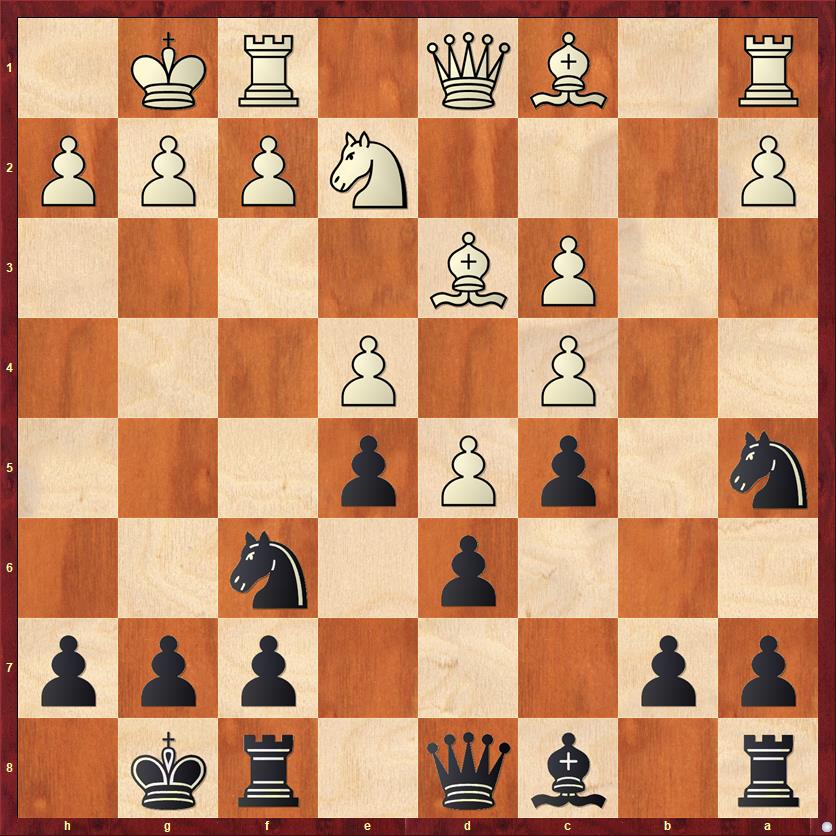
FEN: r1bq1rk1/pp3ppp/3p1n2/n1pPp3/2P1P3/2PB4/P3NPPP/R1BQ1RK1 w – – 0 11
In the main Hubner Variation, with White’s knight on f3, I think that 10. … Ne7 is considered better. But this position is a little bit different. White has to take Black’s threat of … Nf6-d7-b6 seriously. His knight is unfortunately in an awkward place, taking e2 away from the queen. That explains his next move.
11. Ng3 …
After the game I thought that this was a slight error: “11. f4 would be the natural way to challenge Black’s center,” I wrote. However, the computer considers 11. Ng3 to be the best move! If 11. f4 ef 12. Bxf4 Ng4 13. h3 Ne5, Black’s knight gets a nice outpost on e5, and if White plays 14. Bxe5 de, then the other knight gets a nice outpost on d6.
Even if f2-f4 is premature here, I think that a big reason for White’s lack of dynamic pressure in this game was the fact that he delayed this pawn break for way too long. He finally played it on move 41, which was too late!
11. … b6
Now 11. … Nd7 12. Nf5 Nb6 would have been questionable because 13. Qg4 gives White a strong kingside attack.
12. Bg5 h6 13. Bd2 Kh8
Getting ready to build a barricade of pawns on dark squares.
14. h3 Ng8
Perhaps a better move order was 14. … g5 first, then 15. … Ng8 or 15. … Nh7. This move order gives White another chance to play 15. f4.
15. Qe2? …
Allowing Black to carry out his plan. 15. f4 was best.
15. … g5!
The computer still gives White a 0.6-pawn advantage, but I think that this move completely equalizes for Black, and then some. White never gets any semblance of an attack, and the only question is whether Black can find any threats or whether the blocked position will just lead to a draw.
16. Qh5 f6 17. Rae1 Qe8 18. Qxe8 Rxe8 19. Nf5 Bxf5 20. ef …
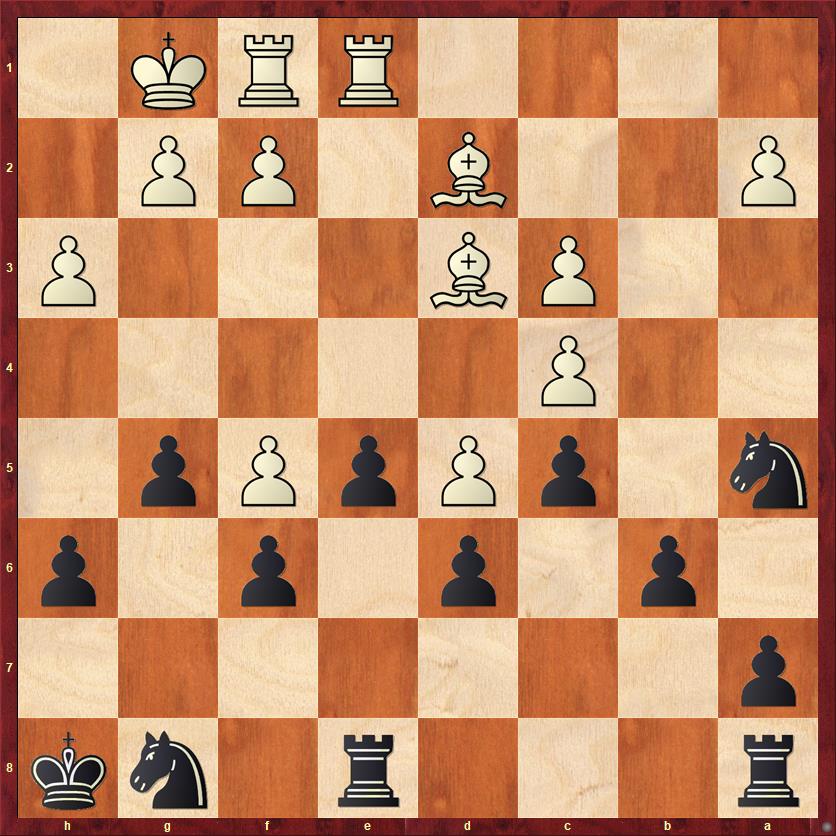
FEN: r3r1nk/p7/1p1p1p1p/n1pPpPp1/2P5/2PB3P/P2B1PP1/4RRK1 b – – 0 20
A key moment in the game, and a position worth talking about. I’ll be interested in readers’ thoughts, too.
First, I think that Nimzovich would be proud of this position. Black has taken the concept of blockade to the extreme. White’s bishops are very sad-looking pieces. There is nothing White can do to break Black’s impenetrable barrier on the queenside. On the kingside, the only active plan for White is to play g3 followed by f4, but so what? It seems to me as if Black can just sit.
However, I did want to win this game, not just sit and wait for a draw. So the next question is: Does Black actually have winning chances?
To answer this question, I think we need to talk about when two knights can be better than two bishops. 2B’s versus 2N’s is an extremely interesting material imbalance. In general, 2B’s are just better than B+N, and B+N is just better than 2N’s, provided that the bishop is a good bishop. That is because both of these imbalances boil down to a comparison of one piece against another.
But when you have 2N’s versus 2B’s, the combination works together in a way that augments the power of the knights. Most obviously, the knights can “gang up,” and the bishops can’t. If the rooks were off the board, and I could put my knights on a5 and b6, I would simply win a pawn. Obviously that’s not possible here, but this kind of teaming up is always a danger if White has weak pawns — and he does in this position.
Also, the knights become stronger if they have outpost squares that they cannot be driven away from. Looking at the diagram, you can see that my position is deficient in that regard. My knight on g8 has no outpost squares and is really a rather sad piece, currently limited to g8, e7, and c8. He would be much happier, for example, on e5. The knight on a5 has an outpost, but it is on the rim of the board and exerts pressure on only one weak point in White’s position, the pawn on c4. This knight would certainly be more effective if it could come to c4 and dominate White’s dark-squared bishop.
Finally, we should look at pawn breaks. For Black, the most obvious pawn break is … b6-b5, which should probably come after … Ne7 and … Rac8. But all of that preparation takes time, and it seems to me that 20. … Ne7 21. g4 Rac8 22. Rb1 would just shut it down. In general, I thought that the break … b6-b5 would be hard to carry out in an effective way.
But there’s another pawn break that is available right now. And it might not be available a move from now, if White shuts it down with 21. Re4. Sometimes, in a maneuvering game, you have many chances to play the moves you want. Other times you only get one chance. I felt that this was one of those use-it-or-lose-it moments.
20. … e4! 21. Bxe4?! …
I’m sure that White thought, “Oh, boy! I get a chance to trade my lame c4 pawn for Black’s strong e-pawn.” What he should have thought was, “Ah, I see that Black is attempting to gain an outpost on c4 for one of his knights and an outpost on e5 for the other. Therefore I should play 21. Be2!, which denies his knight the c4 outpost. Also, notice that the other knight would like to get to e5 but has no route to get there. Its only possible route is Ng8-h6-f7-e5. So Black will want to play … h5, but if he does that immediately, it fails tactically to 21. Be2 h5 22. Bxh5 Nxc4 23. Bxe8 Nxd2 24. Bc6 Rc8 25. Re3 Nxf1 26. Kxf1 Ne7 27. Rxe4 Nxc6 28. dc Rxc6 29. c4, which is clearly better for White. If Black does not do this, but plays a building move like 21. … Re7 or 21. … Re5 instead, then I can start mobilizing my pawns with 22. f4.”
This shows the importance of trying to understand what your opponent is trying to accomplish. The move 21. Be2 looks awkward and passive, but it keeps me from accomplishing my objectives.
21. … Nxc4 22. Bc1 Re7 23. Bd3 Ne5 24. Bb5 a6 25. Be2 R8e8!
Things are not going White’s way. I would be delighted if he took on a6, because 26. Bxa6 Ra8 lets my rooks invade along the a-file. Meanwhile, I have dangerous threats like … Nf3+ and … Nd3.
The computer still thinks White has equal chances after 26. Be3 b5 27. Bh5 or 26. Rd1 b5 27. Bh5. The moves Bh5 and (of course) f2-f4 seem to be key ideas for White to generate some semblance of counterplay. Instead, White drifts into a totally passive position.
26. Be3 b5 27. Rb1 Rb7 28. Rb2 Ne7 29. c4 …
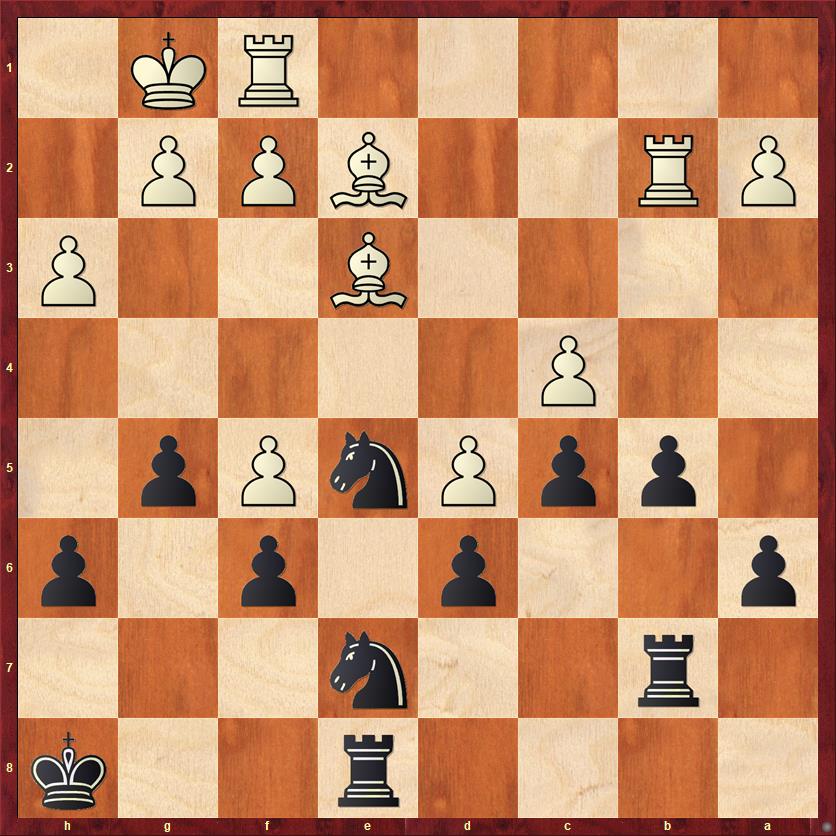
FEN: 4r2k/1r2n3/p2p1p1p/1ppPnPp1/2P5/4B2P/PR2BPP1/5RK1 b – – 0 29
Here it was my turn to make a move that was possibly not best.
29. … b4
I liked the solidity of this move, which once again cements the pawn structure and gives Black a 2-versus-1 pawn majority on the queenside. But chess is also about piece activity as well as pawn structure. This was another one of those use-it-or-lose-it moments, when I could have played 29. … Nxf5! Look at how strong those knights are, compared to White’s bishops! If White wins back the pawn with 30. cb, after 30. … ab 31. Rxb5 Ra7 or 31. Bxb5 Ra8, a new ugly duckling has appeared in White’s position — the a-pawn, which will either be lost or will be stuck on a2. And that’s not to mention another “ugly duckling,” the weak e-pawn that would appear after 32. R1b1 Nxe3 33. fe Ra3. Here Black has an advantage in piece activity and pawn structure.
Still, there is really nothing wrong with 29. … b4, and I think it’s a little bit more Nimzovichian.
30. g4 …
Defending one of his weaknesses. Now we enter another ten-move period of siege warfare before the next outbreak of tactics. By the way, there was a time control at move 40. I don’t have a record of how much time I had on my clock, but knowing me, it probably was getting low. My opponent may have been in the same situation, so both of us had an incentive not to do anything too rash until the fortieth move had passed.
30. … Nc8 31. Rfc1 a5 32. Kg2 Nb6 33. Bf1 Kg7 34. Be2 R7e7 35. Bf1 Rh8 36. Be2 Kf8
Here Black has the possibility of playing 36. … Na4 37. Rbc2 Nc3, with the point that after 38. Bf1 I can now open the h-file with 38. … h5. However, I remind you that I was in time pressure and playing low-risk moves. In fact, I decided to relocate my king to the queenside, where it can protect d6 and be out of the way of any dangers on the kingside.
When the king walks from one side of the board to the other, I call it a “Long March.” In this case, it has no disadvantages, and the possible advantage of having the king in a safer place, and the definite advantage that I can make several moves in a row without taking much time on the clock.
37. Rbc2 Ke8 38. Rb1 Kd8
This move is a little puzzling: why not d7? I think that I was intentionally keeping the square d7 available for my knight.
39. Bc1 Rhe8 40. Bf1 a4
Last move of the time control. Now the position explodes in a completely unexpected way.
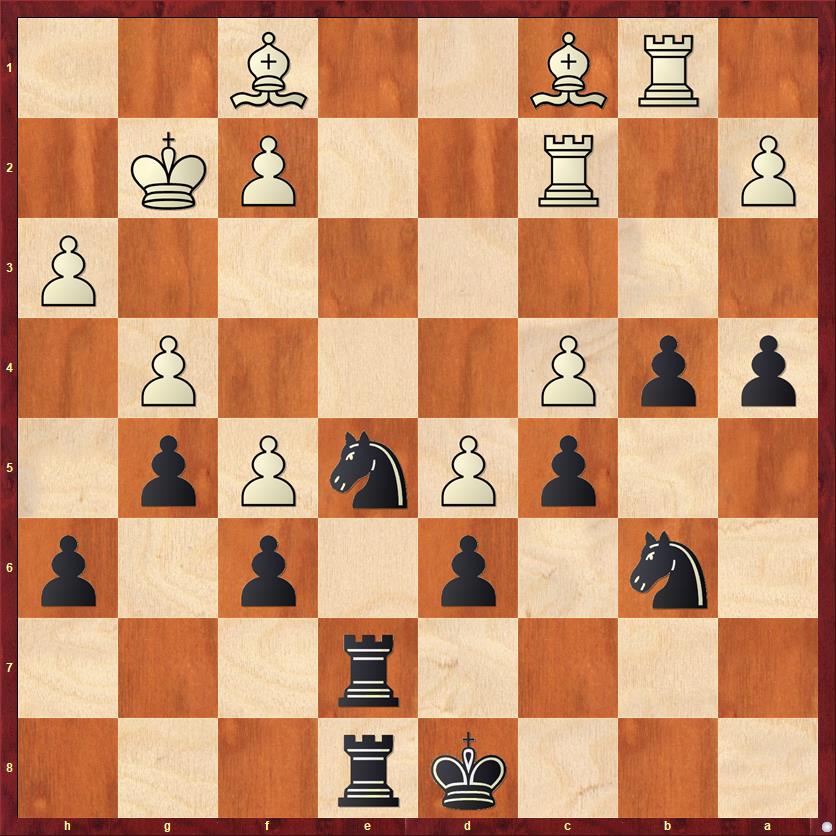
FEN: 3kr3/4r3/1n1p1p1p/2pPnPp1/ppP3P1/7P/P1R2PK1/1RB2B2 w – – 0 41
With enough time to think, White decides that he has had enough of shuffling his pieces around on the back two ranks.
41. f4!? …
Here I feel pretty certain that I changed my mind. My 38th move shows that my intention had been to retreat to d7. But now I had plenty of time to think, too, and I thought I saw a spectacular brilliancy.
41. … N5xc4??/!!
What kind of annotation does a move like this deserve? In my post-game notes I gave it two exclamation points, thinking that the sacrifice was completely sound. The computer gives it two question marks, because Black throws away a probably winning advantage for nothing better than a draw.
Let’s first take a look at how I should have played. My original intention was right: 41. … Ned7 is natural and good. Black’s plan is simply to place his rooks on e4 and d4 and start breaking down White’s queenside. Thus, for example, the game could continue 42. Bd2 (42. fg hg is not as good because Black can bring his knight back to e5. 42. Bb2 gf is not as good because Black can bring his knight back to e5.) 42. … Re4 43. Kf3 Rd4 44. Be3 … (Sooner or later White will have to play this move. Otherwise … R8e4 is just too strong.)
Now Black has an excellent sacrifice: 44. … Rxe3! 45. Kxe3 Rxf4. The winning plan for Black is dead simple. He just brings the knight back to e5 and wins a pawn. If White goes into maximum defensive mode, putting his rooks on c1 and c2, then the silly little pawn push … b4-b3 (followed if necessary by … b3-b2) will force one of the rooks to abandon the c-file. The coordination of all of Black’s pieces, the rook and the two knights and the humble b-pawn, is really spectacular.
This variation is what I would like to call an organic sacrifice. Black builds the pressure to its maximum point with ordinary moves, and then plays a sacrifice that destroys White’s most vulnerable and most critical defensive unit. After that it’s as if the glue holding White’s game together has come apart.
By comparison, my sacrifice on 41. … N5xc4 was an unnecessary, artificial sacrifice. I have not built up the pressure to the breaking point. Instead I thought I had found a short-cut to victory. But there was something I overlooked. Here is what I wrote in my post-game notes.
“If 42. Bxc4 Nxc4 43. Rxc4 Re2+ 44. Kf3, Black’s clearest win is not 44. … Rxa2?! but 44. … a3! [see diagram below] The point is that after 45. Ra1 Kc7! White’s pieces have no moves, and Black can simply stroll to b5 with his king and take White’s rook.”
In other words, I thought I had a zugzwang. Because of the unique arrangement of White’s pieces, I thought White had no freeing moves.
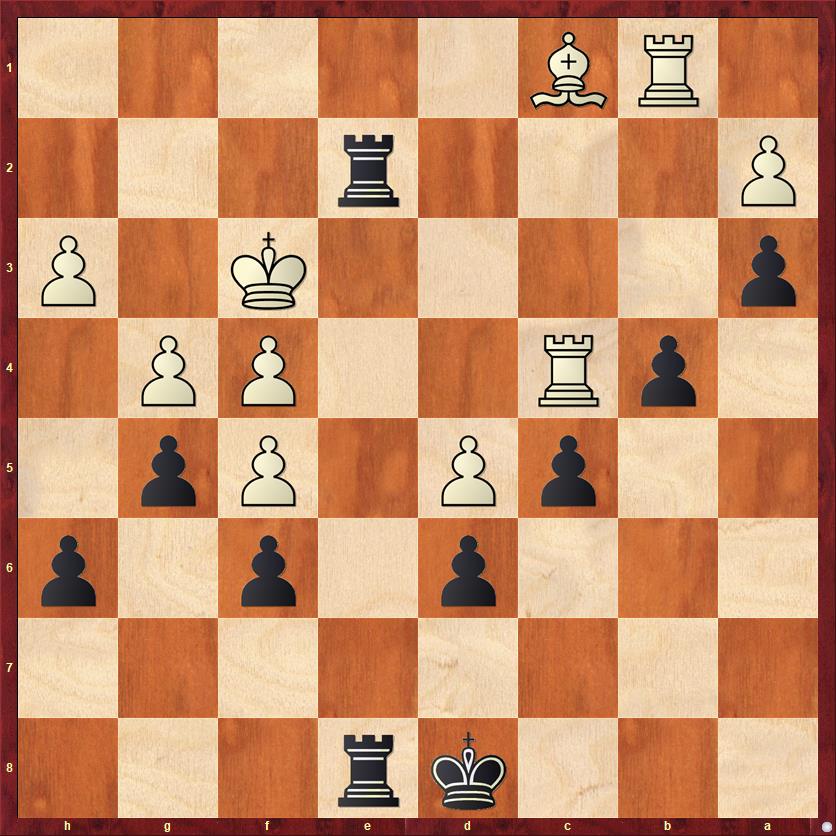
FEN: 3kr3/8/3p1p1p/2pP1Pp1/1pR2PP1/p4K1P/P3r3/1RB5 w – – 0 45
So here’s the question: Is White really forced to place himself into zugzwang with 45. Ra1? If not, what can he do that is better?
The first point to realize is that if White could just move his bishop away from c1, the zugzwang disappears. And he can use pawn breaks to achieve this essential transformation. The idea that I overlooked, both during the game and in my post-game analysis, is 45. fg! hg 46. h4! Black has no good answer. If 46. … gh, White can play either 47. Bf4 or 47. g5. The position has become massively complex, but it is clear that something has gone wrong for Black. The computer evaluates the position at 0.00, but really all three results (win, draw, loss) are in play, and that is a drastically worse situation for me than on move 40, where the position seemed to be either a win or a draw at worst.
The moral of this story, for me, is: Where there are still pawn breaks, there are no zugzwangs.
Earlier this year, when I was playing against the computer over and over, I discovered that I am systematically overlooking pawn breaks in my analysis, especially when the pawn break is a pawn sacrifice. This game is a striking example, where I had a blind spot to the idea of 45. fg and 46. h4! It’s as if I told myself, “There’s no need to pay attention to these moves. They’re meaningless pawn moves, and as soon as he runs out of pawn moves, he’ll be in zugzwang.”
I’m still sort of in mourning for the loss of my deep and very Nimzovichian idea. I thought I had won this game in a way that would make Nimzovich proud. But in the end, it was just a wrong idea. And I got too emotionally attached to it. I should have looked at it calmly and asked, “Do I need to play this sacrifice? Do I have to go out on this precipice, or can I play simple chess and build my advantage?”
The goal of chess is to win. It is not to play the cleverest piece sacrifice you can find.
But there is one more piece of unfinished business here. What actually happened in the game?
Well, what actually happened in the game was that my opponent was convinced! He thought my attack after 43. … Re2+ was as overwhelming as I thought it was. So he played a different variation! In diagram four, White played:
42. Rxc4? …
So here’s the other thing about sacrifices. Fortune favors the brave! If you play wicked sacrifices like 41. … N5xc4, you will induce many opponents (who are not computers) to make mistakes. I’m not saying that you should deliberately play bad sacrifices. But if you see one that you think is winning, and you can’t see anything wrong with it, and you don’t have any other move that is clearly better, then what the hell. Go for it.
42. … Nxc4 43. Bxc4 Re1!
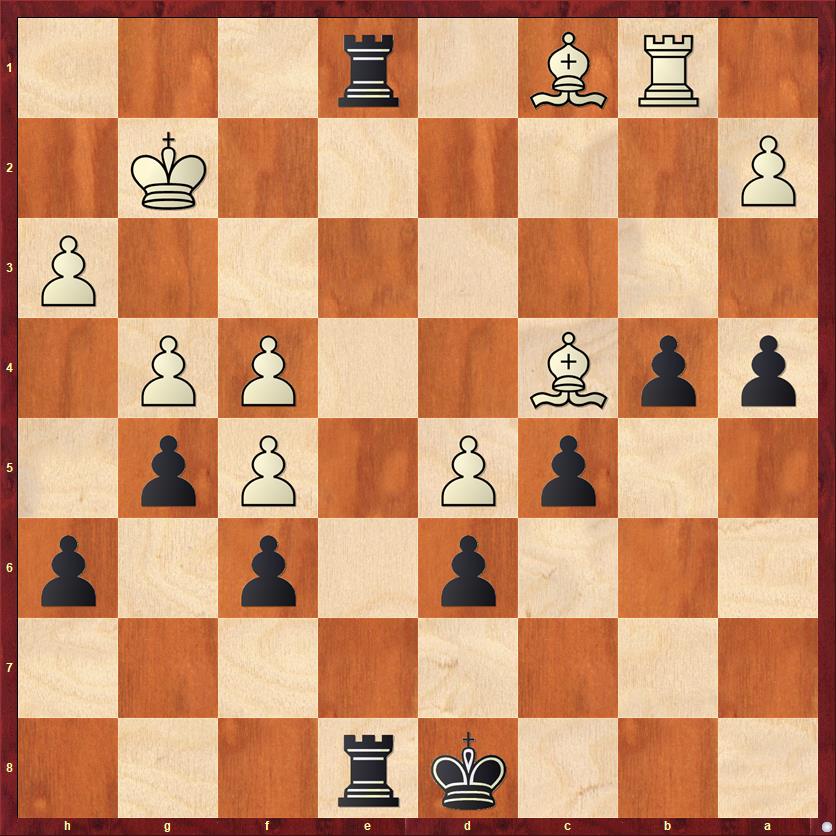
FEN: 3kr3/8/3p1p1p/2pP1Pp1/ppB2PP1/7P/P5K1/1RB1r3 w – – 0 44
Instead of two bishops against two knights, White now has two bishops against a rook and pawn. In many positions that would be a winning advantage… but not in this position, where the rooks are running roughshod over White’s position and the bishop on c1 is pinned. White tries to unpin it, but without success.
44. fg hg 45. Bd3 Rd1 46. Bxg5 …
Desperation. 46. Bc2 runs into 46. … Re2+, and after any other move 46. … R8e1 will win a piece.
46. … Rxd3 47. Bxf6+ Kd7 48. Rb2 R8e3
Chipping away at White’s phalanx of pawns.
49. Bh4 Rxh3 50. Bf2 Rhf3 51. Re2 Rf4
Winning another pawn, until White’s next move gives me a better option.
52. Be3 Re4! 53. resigns
If 53. Kf3 or 53. Kf2, I simply trade everything off: 53. … Rxe3 54. Rxe3 Rxe3 55. Kxe3 b3. My passed pawn is too far away for his king to catch. Notice that 56. ab would be met not by 56. … ab? but by 56. … a3!
Lessons:
- Fortune favors the brave. Against human opponents, unclear or not-completely-sound sacrifices will work more often than they “should” (at least according to a computer).
- Nevertheless, there are times when the right thing to do is see a sacrifice, analyze it, and then not play it. If you see a move that is objectively better, play that move instead. The goal of chess is to win, not to play the cleverest sacrifice.
- Learn to discriminate between an organic sacrifice and an artificial one. An artificial one is a sacrifice that just happens to be there, but isn’t the fundamental reason why your position is better. An organic sacrifice is one that appears when you stretch your opponent’s position to the breaking point and you just need to eliminate one key defender, open one key line, etc., to cause it to collapse.
- Don’t take your opponent’s word for it. Often the way to refute a sacrifice is to accept it. This may require just as much courage as it did for him or her to offer the sacrifice.
- It’s not a zugzwang if your opponent still has pawn moves — especially if they are pawn breaks that change the nature of the position.
- Even in a slow, maneuvering game, be on the lookout for use-it-or-lose-it moments, i.e., opportunities to play a move that you probably won’t get another chance to play.
- Two knights can be better than two bishops if they have good outpost squares, if the position is relatively closed, and if they can “gang up” to win material.
- In a closed position, a Long March (moving your king from one side of the board to the other) is sometimes a good way to: (a) make a lot of moves in a small amount of time if you are in time pressure, and (b) get your king away from the side of the board where you want to open lines or where you expect lines to open.



{ 6 comments… read them below or add one }
Thanks for the story about your name, as I had been curious about how you ended up a “Mackenzie.” Speaking of names: in the early 80s, I drove down to the Lipkin-Pfefferkorn Open in Winston-Salem with a national master whose name at that time was “Mess,” which he changed eventually to protect his expected child from teasing. That tournament was still going strong until just a few years ago under that hyphenated surname, so I assume that “Lawrence Pfefferkorn” is a mistake. Just FYI.
Hi Michael,
Thanks for the correction! Yes, you’re right that it was Lipkin-Pfefferkorn. At some point in my mind that changed to “Lawrence.” Yet another reason why it’s good for me to write these retrospectives, so that people can correct all my faulty memories!
I will make the correction above.
I’m surprised you didn’t mention George Mackenzie. 🙂
BTW, we recently moved to Ohio – and live in Dublin now.
Re: 2N vs 2B. I think John Watson has a wonderful piece on the topic in his “Modern Chess Strategy” book.
Re: pawn breaks. In the ongoing STIGES tournament, in the 5th round game there was the game Csiki – Stefanova. White, a 15-y.o. FM managed to lose a 4on4 rook endgame to his opponent, a former Women WC.
It turns out that White made a terrible blunder on move 38 in that endgame and Black failed to capitalized on it, but still won. Can you find it? 🙂
W: Kc2, Rb5, pp e4,f3,g2,h4
B: Kf6, Ra6, pp e7,f7,g6,h5
38. f4 ??
Hi Roman! Well, it did occur to me, when I took my new name, that I could become the second U.S. champion named Mackenzie. Alas, though my name made it possible, my lack of talent ruled it out.
I’ll look up that Watson book! My break from tournament chess should give me time for more reading.
Finally, in your puzzle, the solution has to be 38. … Ra2+ 39. Rb2 (White can’t allow the loss of the g-pawn, which would be followed by the h-pawn) Rxb2+ 40. Kxb2 e5 (pawn break #1) 41. g3 (otherwise White just loses a pawn) ef 42. gf g5 (pawn break #2). Taking with the h-pawn gives Black an unstoppable passed pawn on the h-file, and taking with the f-pawn allows 43. fg+ Ke5 etc. Black wins the e-pawn and h-pawn. White does not have enough time to win Black’s f7-pawn, and 44. Kc3 Kxe4 45. Kc4 Kf4 46. Kd4 Kg4 47. Ke4 Kxh4 48. Kf4 Kh3 49. Kf3 h4 breaks Black’s king out of jail.
Besides pawn breaks, this endgame also is a great example of thinking a king-and-pawn endgame is an obvious draw when it’s not. I’ve lost games that way, too! Maybe the warning flag for White should have been the fact that his king gets lured all the way to b2, so far away from the action.
I hope you enjoy life in Ohio! I’ve been through Dublin a few times; I lived maybe an hour’s drive away from there.
Your solution is correct! I think it’s a very nice educational example. I gave it to my son who was able to solve it after just a couple of small nudges.
I would also heartily recommend this https://timkr.home.xs4all.nl/chess2/diarytxt.htm – item #392.
Are you familiar with Tim Krabbe’s website? I have the honor of knowing him personally, he took me for a chess cafe tour in Amsterdam in the year 2000.
Looks like we both might have been right. A little googling uncovered a story from Bill Wall, where he says the original name of the tournament was the Lawrence Pfefferkorn Open, but when Mr. Pfefferkorn passed and Dr. Alan Lipkin had been directing the tournament for a number of years, the hyphenated name was born. It’s entirely possible people still called it the Lawrence Pfefferkorn Open, at least informally, when you played.
Source:
https://www.chess.com/clubs/forum/view/dr-al-lipkin